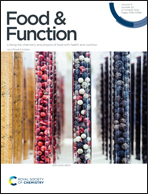A dynamic in vitro oral mastication system to study the oral processing behavior of soft foods
Abstract
A bolus-oriented artificial oral mastication system was developed to simulate the dynamics of food mastication in the human mouth. The system consists of a chewing unit, a bolus forming unit, and provisions for the dynamic incorporation of saliva during mastication. The system performance was validated with in vivo trials (n = 25) considering time-dependent changes in particle size, textural attributes and rheological behavior of the bolus. Idli, a fermented and steamed black gram-rice-based Indian food was considered the model soft food for all trials measured in triplicates. The mastication dynamics were evaluated by analyzing bolus properties during every 3 s of mastication. Large strain shear rheology tests revealed that the viscosity of the sample decreased over time. Results of in vivo trials follow close trends in particle size and rheological behavior and have no significant change in correlation with in vitro mastication results. Similar observations were made in the half softening time of idli during mastication as determined using the relative change in hardness (hardness ratio (Ht/H0)) values fitted to the Weibull model. Also, a model to simulate the time-dependent changes in bolus adhesiveness was developed.



 Please wait while we load your content...
Please wait while we load your content...